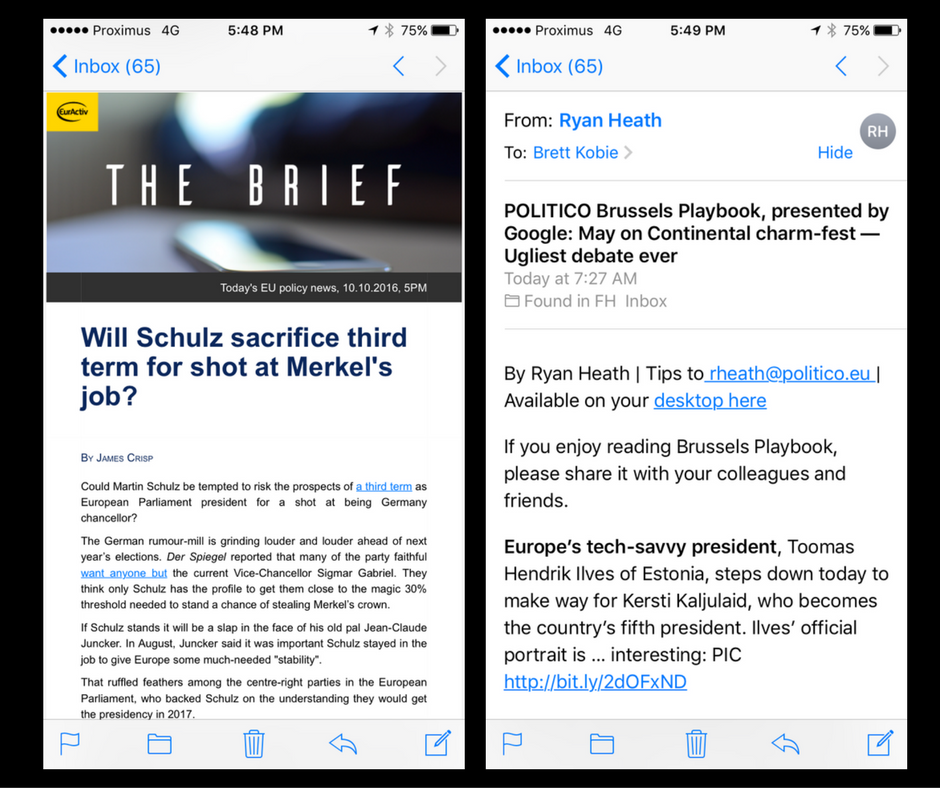EurActiv's The Brief, POLITICO's Playbook and the impending Brussels bubble e-mail newsletter renaissance
When it comes to reaching the EU bubble, POLITICO and EurActiv have shown us that email works…when done well.
It was April 2015 when POLITICO’s Playbook first hit Brussels inboxes around 7:00. In no time, we were hooked on Ryan Heath’s daily collection of must-knows and signature attitude.
A few weeks back, EurActiv, long known for its range of newsletter products introduced The Brief, penned by the brilliant James Crisp, to deliver a 5pm compendium described in its Twitter bio as “a snappy, idiosyncratic take on the day’s EU policy news…served up with style, sass and snark.”
In a time of inbox overload, we still welcome these as part of our daily information consumption routine, but why?
Newsletters: why they work
The Playbook and The Brief work because they solve a problem. Brussels bubblers are bombarded with a million different sources of information on a daily basis and they want help making sense of it. They’re looking for expert curation they can trust and that’s what Messrs Crisp and Heath are delivering.

They take what is mostly freely available information from across the internet and craft that into a concise narrative of what today will be or was about.
Essentially, they’ve taken the place of our non-existent pan-European television news cycle – there’s not enough money in the “European public sphere” to fund a CNN and BBC to blather on 24/7 about what’s happening so we count on them to take their place. And if it’s only Monday-Friday during office hours, we’re ok with that (Brussels doesn’t really do weekends).
Respecting the user experience
Across the board, information products succeed when they take pains to reduce the burden of consuming them.
Playbook’s bare-bones, no-image formatting for example, screams “easy to read!” And it’s short paragraphs suggest that “yes, you do have time to skim through this.”
By not adding a link in every blurb (or adding it only at the end of the blurb) it also makes clear that your reading experience takes priority over the need to drive traffic to POLITICO’s articles.
As EurActiv’s The Brief finds its feet, don’t be surprised to see it drop the html template and header image in favour of a more streamlined approach that better recognizes our collective 5pm attention constraints.
What Brussels communicators are learning
Newsletters are a mainstay of bubble communications, especially in the association world. They’re considered must-haves, if only for communicating to internal audiences.
But an enterprising few have taken note of our new appetite for no-nonsense e-mail communications and are putting techniques honed by the media world to good use.
The ingredients to effective e-mail comms: great, easy-to-read writing, a clear point of view and information presented in a way that can’t be found elsewhere. In a bubble where niche communities and obscure issues dominate, the Playbook and The Brief can only cover so much, leaving it to the rest of us to fill in the gaps.
While “sass and snark” are probably better left to the professionals, there is a tonne of space for your newsletter to tell a story like no other to an audience that is clearly just waiting for you to finally do that.
Still room in your inbox for one more newsletter? The FleishmanHillard Digital, Social & Creative Team’s occasional update offers plain text that helps you do things (Don’t pretend you didn’t see that coming).
Find Out More
-
EU climate policy: The new borderlines?
May 27, 2024


